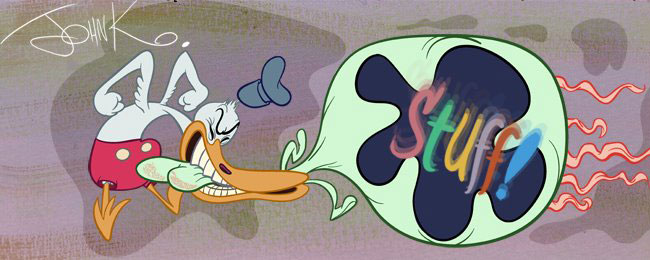I had thought that because this was such a frenetic sequence, there must be a lot of scene cuts in it. It turns out there are only 3.
A lot of story information is conveyed in the short sequence, and McKimson uses all the animation and film tools available to him. He doesn't use the same tool to tell each story point. He varies them and coordinates them to make it exciting. A lesser director could have merely conveyed the story information.
Accents: McKimson separates the previous gag (beating up the dog unwittingly) from the next sequence with an accent. The accent is this big take showing Foghorn realizing that he was smacking the dog.
 Posing and animation. These are the most obvious tools of a cartoon director. He tells much of the story through the drawings and animation. The director draws a lot of the key poses himself and then casts the scenes according to which animator he feels is best suited to a particular scene or sequence. He also gives the animator a good idea of what he wants.
Posing and animation. These are the most obvious tools of a cartoon director. He tells much of the story through the drawings and animation. The director draws a lot of the key poses himself and then casts the scenes according to which animator he feels is best suited to a particular scene or sequence. He also gives the animator a good idea of what he wants. Variety: The animator in this scene varies the amount of exaggeration for each action. The run is less exaggerated than the take that happens just before it.
Variety: The animator in this scene varies the amount of exaggeration for each action. The run is less exaggerated than the take that happens just before it. Camera Pan: Foghorn runs in the opposite direction from where he was in the previous scene.
Camera Pan: Foghorn runs in the opposite direction from where he was in the previous scene. The camera pans with him and pans in another location-the barn.
The camera pans with him and pans in another location-the barn. Timing/pacing: The action pauses and changes pace. After a fast run (4x per step) Foghorn stops in front of a ladder long enough for the ladder to register with us. He looks around frantically.
Timing/pacing: The action pauses and changes pace. After a fast run (4x per step) Foghorn stops in front of a ladder long enough for the ladder to register with us. He looks around frantically. The inbetweens are extreme smears and Foghorn's poses are far apart as he looks left and right.
The inbetweens are extreme smears and Foghorn's poses are far apart as he looks left and right.

Timing, Pause: McKimson has Foghorn turn around look up and pause again to reinforce the ladder and to tell us that Foghorn sees his method of escape.
LOOK UP, HOLD

STARTS CLIMBING
 Cartoon Effects: To reinforce the speed and frenetic escape, Foghorn's feathers trail of in the opposite direction of his climb. This movement in the opposite direction helps propel the action with more force. This is the kind of thing that used to come natural to even conservative directors an animators, but would probably seem radical today. "Too cartoony" would be the note you'd get from the bland police that rule animation.
Cartoon Effects: To reinforce the speed and frenetic escape, Foghorn's feathers trail of in the opposite direction of his climb. This movement in the opposite direction helps propel the action with more force. This is the kind of thing that used to come natural to even conservative directors an animators, but would probably seem radical today. "Too cartoony" would be the note you'd get from the bland police that rule animation.
CUT 2 REVEAL DOG WITH WATERMELON
 Cutting, changing P.O.V: This is a strange choice. For some reason, McKimson decided to give away the punch line. He reveals to us that the dog is waiting for Foghorn with a watermelon. This seems to defy normal gag construction but I never really thought about it until I broke the sequence down to look at it. It's only on for 30 x and within the sequence somehow fits the rhythm. Rhythm is a lot more important to the emotional effect of a film sequence than strict narative logic. You can't write rhythm in words or even on a storyboard. It's the director's job.
Cutting, changing P.O.V: This is a strange choice. For some reason, McKimson decided to give away the punch line. He reveals to us that the dog is waiting for Foghorn with a watermelon. This seems to defy normal gag construction but I never really thought about it until I broke the sequence down to look at it. It's only on for 30 x and within the sequence somehow fits the rhythm. Rhythm is a lot more important to the emotional effect of a film sequence than strict narative logic. You can't write rhythm in words or even on a storyboard. It's the director's job.CUT 3 - Climb Ladder
 Camera angle mixed with frenetic animation: This dramatic angle combined with the way the animation flows just fits together perfectly. It is more dramatic than the straight N/S E/W angles before it and makes the sequence of cuts build steadily to a climax.
Camera angle mixed with frenetic animation: This dramatic angle combined with the way the animation flows just fits together perfectly. It is more dramatic than the straight N/S E/W angles before it and makes the sequence of cuts build steadily to a climax.ACCENT END OF GAG: The building pace comes to an abrupt stop with the topper gag.
 Pacing/contrast: Stop action, slow pace, conclude with calm dialogue.
Pacing/contrast: Stop action, slow pace, conclude with calm dialogue. After the fast paced series of scenes and Foghorn is defeated, McKimson eases us out of the scene with a line of dialogue. "Some days it don't pay to get out of bed." The line isn't funny on its own. It's just there to give us a breather and let us laugh at the end of the sequence.
After the fast paced series of scenes and Foghorn is defeated, McKimson eases us out of the scene with a line of dialogue. "Some days it don't pay to get out of bed." The line isn't funny on its own. It's just there to give us a breather and let us laugh at the end of the sequence.WHAT DOES A CARTOON DIRECTOR DO THEN?
We still use the term director for various jobs in animation today but it doesn't mean what it used to. Many modern directors are merely timers. After an assembly line of writers, designers, executives and production coordinators take swipes at different ingredients of the animation process, then the director is called in to connect everything in order using preset timing formulas.
In the old days, "Director" meant total control of the creative aspects of the cartoon. What was funny about the sequence above was not merely the gags as written, but how all the elements of the performance: the cutting, the voices, the animation are put together to create the emotional and humorous effect of what is happening.
McKimson uses variety in his timing, animation, exaggeration to build the sequence to a big finish, not merely to tell us the events in order.
Compare this to modern cartoons which hang everything on the limited power of the written (or spoken) words alone. These types of shows don't seem to use direction. There is no personal point of view, nor is there any virtuoso performance. The stories just plod along at an even monotonous pace and one bit of information or gag never seems any more important than the next bit of information. I never know when to laugh when I watch modern cartoons because they are so devoid of pacing or feeling. Everything is timed the same way, the animation never varies. It's about as fun as watching a spoon stir soup. You also can't tell one artist from the next so there is no casting of the strengths of the artists. The voices all drone along in their repetitive digital rhythms, adding to the sedative effect of the robotic assembly line generic cartoon product.
EACH CREATIVE ARTIST IS A UNIQUE CUSTOM TOOL
A classic cartoon director is a choreographer. He has a specific set of tools and uses each tool for different purposes. All the creative staff are part of the tool kit. The director needed to understand the special abilities of each artist - including the voice talent, composer, layout artists and sound effects editor. He builds his stories around his specific talents-rather than forcing all the talents into some preconceived rules created for a story bible and production manual.
If each artist has some unique ability that the other artists are not as good at, common sense leads a director to take advantage of all those unique abilities. It makes less sense to me to make each artist lessen his special gifts so that what is left matches each of the other artists. That's what we do in most productions today- sand everyone down into softer blander replicas of each other.
In the 1940s, the directors created their entertainment around the special talents of their crew. If Mel Blanc could do a certain type of delivery, you wrote something to take advantage of it. You used your different animators for different types of scenes. You couldn't have just shipped your storyboard to a foreign land and expected the cartoon to come back with the scenes playing to the strengths of the artists.
Modern animation (meaning animation from the 1960s to now) has an opposite approach to creativity. Rather than using all the tools that are available to whoever is in charge and creating entertainment out of all the ingredients, we have instead made a system that depends on arbitrary preset rules and outright fear of creativity. We have a very limited and blunted toolkit. Modern cartoon makers tend to despise especially the tools that are most natural to cartoonists. The whole process is geared to dehumanizing the medium.

